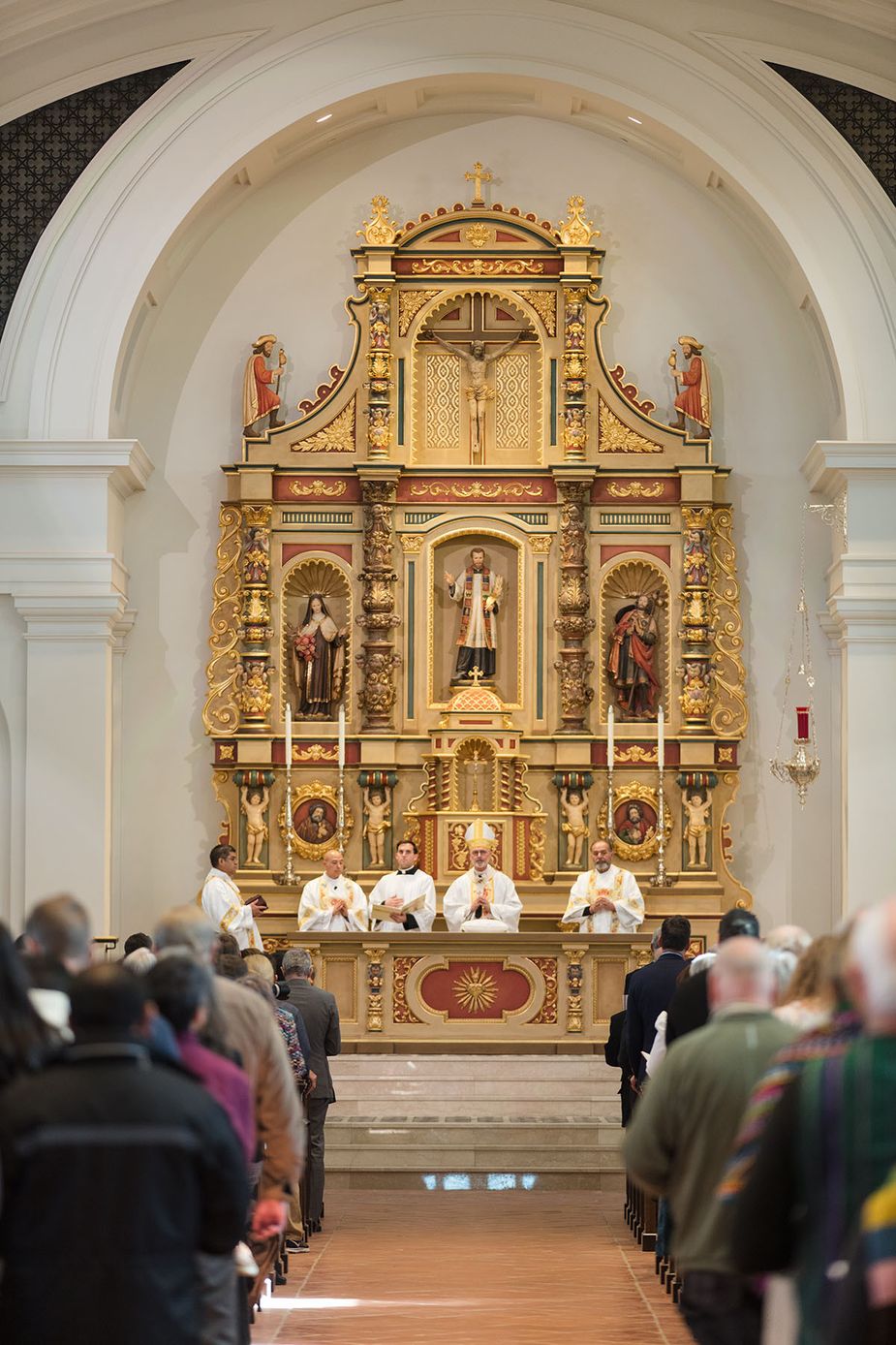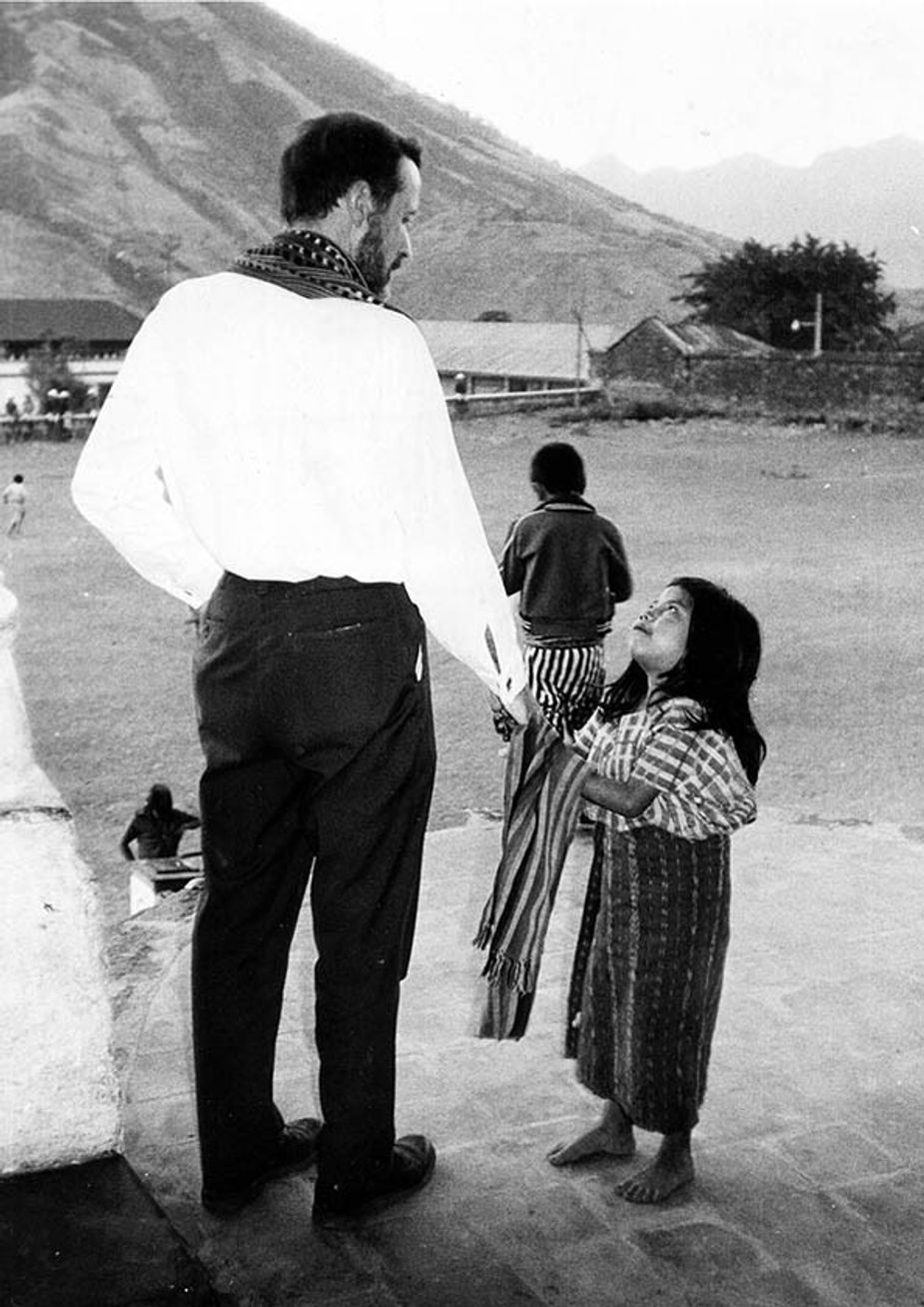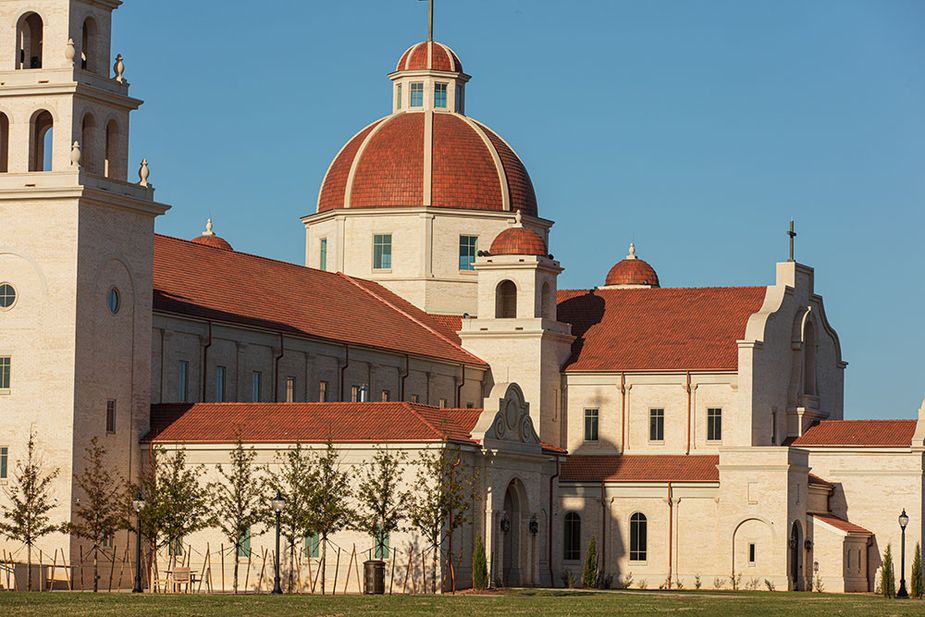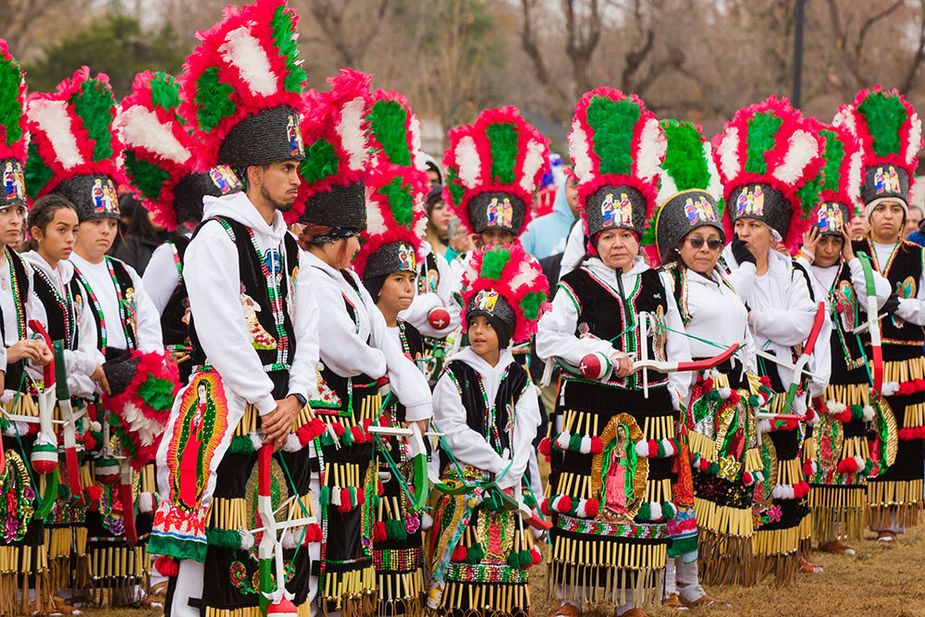Blessed Is He
Published April 2024
By Brooke Adcox | 17 min read
Golden sunlight bounces off the bright cream exterior, orange terra cotta-tiled domes, scrolled arches, and bronze crosses of the towering Blessed Stanley Rother Shrine, bathing the Spanish baroque and mission-style church with visual warmth reminiscent of the Latin American churches that served as its inspiration. The glowing cathedral is sharply contrasted by the crisp, near-freezing temperatures of a bright February Oklahoma morning—a reminder that while this structure feels like it should be in a historic Mexican town square, it’s intentionally placed on a fifty-three-acre swath of land in southeast Oklahoma City.
In fact, everything is intentional about this place, from the grand main church and intimate prayer chapel to the sprawling pilgrimage center and leisurely plaza. The new $50 million facility now is Oklahoma’s largest Catholic church, a feat organized to honor the United States’ first papally recognized martyr: Blessed Stanley Rother, a priest from Okarche, Oklahoma.
“Blessed Stanley, pray for us,” chant the crowds that stretch around the building. This morning, thousands of faithful are waiting to be among those who witness the church and altar dedication Mass. They chat in a mix of languages, sharing the locations of their home parishes and their excitement to see the culmination of the multiyear project.
Then the transition begins. The church accepts the visitors, the 3,600-pipe organ rings with the accompaniment of a robust choir, the walls and altar are anointed and incensed, and the Catholic faithful celebrate the Eucharist. And after, this new place built on Oklahoma soil becomes a sacred space, one that is blessed.

The Blessed Stanley Rother Shrine in Oklahoma City was dedicated in February 2023. It is open daily to visitors, and on July 28, it celebrates the Feast Day of Blessed Stanley Rother. Photo by Brent Fuchs
“It’s a very Oklahoma story,” says the Very Reverend Donald Wolf, a first cousin of Blessed Rother and current rector of the Blessed Stanley Rother Shrine and Sacred Heart churches. “The first thing about Stan’s life is that it’s a life you know and recognize, because you’ve met one thousand people like Stan Rother. You might be one.”
Stanley Rother was born to Franz and Gertrude Rother, a German farming couple, in Okarche in 1935. The oldest of four children, he spent his childhood working the farm, milking cows, and collecting eggs before heading to the nearby Holy Trinity Catholic School. It was assumed that Blessed Rother would take over the family’s farm, but in 1953, the eighteen-year-old announced he would enter seminary.
Seminary was a challenge. He struggled learning Latin, a requirement for theology studies. In a letter to Oklahoma City Bishop Victor Reed, the rector of Rother’s first seminary wrote that he lacked “intellectual ability to continue on for the priesthood.” But the archdiocese’s leaders rallied around him, helping him locate another seminary where he could continue his studies.
.jpg)
Stanley Rother was raised on a farm in Okarche before eventually joining the seminary. Here, he is photographed at a carnival. Photo courtesy Archdiocese of Oklahoma City
Blessed Rother soon graduated from Mount St. Mary’s Seminary in Maryland, having passed Latin and theology. He was ordained into the priesthood on May 25, 1963, at the Cathedral of Our Lady of Perpetual Help in Oklahoma City and was immediately put to manual works of service, including clearing land and preparing retreat cabins on Lake Texoma. His priestly humility was present in his personal life as well.
“At family gatherings, he was just one more cousin,” says Wolf. “He wasn’t born with a halo, and while he was the priest, he was just one of the family.”
In 1968, Blessed Rother joined the Micatokla mission, an Oklahoma-led mission in Santiago Atitlán, Guatemala. He worked with a mission team to improve the rectory of La Iglesia Parroquial de Santiago Apóstol—established in 1547—and build a new hospital. He learned Spanish and Tz’utujil, the language spoken by the Indigenous Mayans in the area. The mission work slowed, and by 1975, Blessed Rother was the only priest who remained.
Blessed Rother was called “Padre Francisco” or “Padre Apla’s” by the approximately twenty-five thousand he served. He performed the traditional roles of a priest, such as conducting mass or blessing children, but he was more known for his ability to drop everything and help. Blessed Rother fixed vehicles; grew wheat, corn, and garlic with local farmers; ate in the homes of those in remote villages; found homes for orphaned children; fed the hungry (he was known to cut the meat for and eat lunch with a local elderly homeless man each day); and worked to help translate the New Testament into Tz’utujil.
“There was a horrible earthquake in Guatemala in ’76,” says George Rigazzi, archivist for the Archdiocese of Oklahoma City. “He was one of the few people who would go into ravines to try to rescue people, because it was so dangerous. But that’s who he was.”

Blessed Rother and parishioner Elena Petzey in Santiago Atitlán. Photo courtesy Archdiocese of Oklahoma City
The Guatemalan Civil War, which ran from 1960 to 1996, began to affect Santiago Atitlán in 1980, when the area was occupied by the army and catechists were kidnapped, tortured, and executed. During this time, Blessed Rother wrote, “The shepherd cannot run at the first sign of danger.” And in another letter, he wrote, “If I get a direct threat or am told to leave, then I will go. But if it is my destiny that I should give my life here, then so be it. . . . I don’t want to desert these people.”
Blessed Rother fled to Oklahoma on January 28, 1981, after a threat to his life. However, he wouldn’t leave until he secured a visa for Reverend Pedro Bocel, a local Indigenous Kaqchikel man who worked by his side. After four months, Blessed Rother returned to reside to Santiago Atitlán, driven by his promise to protect the flock.
“Having been to Guatemala, it’s easy for me to see how Blessed Stanley totally fell in love with those people. They’re beautiful people,” says Deacon Norman Mejstrik, director of permanent diaconate and Rother Cause, the official campaign for Blessed Rother’s beatification. “I believe he knew he would be killed. He still went back knowing his name was on a death list, knowing they were coming to get him.”
Reverend Wolf recalls his cousin’s final journey to his home state.
“Stan’s last trip to Oklahoma was for my ordination. It was May 1981,” he says. “We were standing in line to go into the cathedral in procession. One of the other priests came by and said, ‘You know, Stan, you’re down in Guatemala now for all these years. One of these days, maybe you could bring some of the priests from Guatemala up here.’ Stan says, ‘No, I haven’t come to bring people up here. I’ve come to get Don to bring him down there.’ He turns to me and says, ‘You know, really, it wouldn’t be that dangerous for you.’”
Blessed Rother was killed on July 28, 1981, when three men broke into the Iglesia de Santiago Apóstol rectory and shot him after a physical altercation.
“The last time I saw Stan, he left my aunt and uncle’s house after supper,” says Wolf. “None of us knew that ninety days later, he’d be back at the cathedral, lying in a coffin.”

At 38,000 square feet, the Blessed Stanley Rother Shrine is the largest Catholic church in the state. It was constructed over four years by The Boldt Company in Oklahoma City and designed by Franck & Lohsen Architects in Washington, DC, with support from ADG|Blatt Architects in Oklahoma City. Photo by Brent Fuchs
The Guatemalan parish mourned Blessed Rother at a funeral that was so crowded, the church pews had to be removed to accommodate more people. While his body was returned to his family for burial, his heart and a jar of his blood remained at Iglesia de Santiago Apóstol.
“They wanted something to symbolize that he was still with them,” says María Ruiz Scaperlanda, author of Blessed Rother’s biography The Shepherd Who Didn’t Run. “I know for most Americans, it is a little freaky, but it’s really quite beautiful.”
Blessed Rother originally was buried at Holy Trinity Cemetery in Okarche, though his body now is interred in the wooden altar at the shrine’s 144-seat chapel, the result of a nearly four-decade journey that gained momentum in the 2000s when the Archdiocese of Oklahoma City organized a cause for Rother’s canonization.
“We gathered up everything written by him, to him, and about him. And by the time we sent off all the documents in 2010, there were more than seven thousand pieces of information to be sent to Rome,” says Rigazzi.
The effort was fruitful. In 2016, Pope Francis declared Rother a martyr, and in 2017, he was beatified, giving him the recognition of Blessed.
“We need to prove a miracle for him to become a saint,” says Mejstrik, who leads a team that collects and evaluates favors attributed to the intercession of Blessed Rother. “If the favor looks legitimate, it can be sent to Rome for their review and assessment. And if it’s found to be a miracle, that may be the quickest way for him to be canonized as a saint.”
As a martyr, Blessed Rother was able to receive beatification without a verified miracle. The work of collecting and verifying miracles for his possible sainthood continues.

Blessed Stanley Rother's likeness is the centerpiece in a *retablo* that overlooks the church's sanctuary. Photo by Brent Fuchs
“Part of the experience of the shrine is the beauty,” says Leif Arvidson, executive director of the Blessed Stanley Rother Shine. “The beauty of the architecture, art, statues, and paintings. And the beauty of traditional Catholic devotions: praying the rosary and honoring the saints, especially Blessed Stanley and Our Lady.”
A visit starts with the 6,000-square-foot Pilgrim Center and Museum. The museum is organized in three areas: Blessed Rother’s early life and faith formation, the Guatemalan mission and his death, and his beatification and lasting impact. The space includes interactive exhibits and artifacts from Blessed Rother’s life, including his stoles, rosary beads, and family photographs.
Guests can visit the church or attend one of the daily masses offered in English or Spanish, as the shrine also is home to local congregations. The 2,000-seat church provided the space for the archdiocese to combine two churches and better support Oklahoma City’s growing Hispanic community.
“Our work is to connect the life of the church in Oklahoma and its 120 years here with the people who are now newly among us,” says Wolf. “We make a place, learn their language, respond to their needs, and conform our expectations to what they have to offer.”

More than 3,000 visitors gathered for an outdoor mass at the shrine on December 11, 2022. About sixty Matachines dancers joined parishioners in a procession to the shrine. Photo by Brent Fuchs
Outdoors, visitors can see Tepeyac Hill, a recreation of Our Lady of Guadalupe’s apparition to St. Juan Diego, a pivotal event for the church in Central America. Here, a path winds around the perimeter of the hill that leads guests to the apex, a landscaped area featuring the prominent twelve-foot statue of Our Lady and eight-foot statue of the saint.
Latin American inspirations continue in the main church, including a custom twenty-seven-foot-tall retablo, a hand carved, intricate wall treatment that features a crucifix, saints, and at the center, an original statue of Blessed Rother. The altar area is flanked with statues of Blessed Virgin Mary and Saint Joseph colored with soft creams, blues, and reds. Along the center aisle, there are rich paintings that depict Jesus’ last day, hand-painted replicas originally featured in the Cathedral Basilica of Our Lady of the Immaculate Conception in Puebla, Mexico.

The shrine's dedication ceremony took place on February 17, 2023. Photo by Brent Fuchs
“All the details that are there culminate in the small chapel where his body rests,” says Scaperlanda of the chapel with a sweeping mural that fills an entire dome. “I looked up, and I saw that beautiful rendition of him being welcomed into Heaven by our savior. There he is with his arms open to Blessed Stan, and Stan is reaching up to him with all the other martyrs.”
Blessed Rother gave his life in service to his faith and his fellow humans; he often is described as an ordinary man who lived an extraordinary life worthy of celebration and reflection.
“Think about this for a second: A farm boy from Okarche, Oklahoma, is recognized by the universal church of 1.3 billion people as a Blessed, and he’s one step away from being canonized a saint,” Rigazzi says. “A kid from Okarche! You know, anything is possible.”







